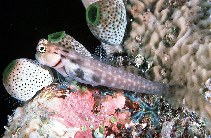| Family: |
Blenniidae (Combtooth blennies), subfamily: Salariinae |
| Max. size: |
4 cm TL (male/unsexed) |
| Environment: |
reef-associated; marine |
| Distribution: |
Western Indian Ocean: known only from Maldives. |
| Diagnosis: |
Dorsal spines (total): 12-13; Dorsal soft rays (total): 13-14; Anal spines: 2-2; Anal soft rays: 15-16; Vertebrae: 31-32. Dorsal fin XII or XIII,13 or 14 (rarely XIII); Incised spinous and segmented-ray portions. Anal fin II,15 or 16. Pectoral fin 12-14 (typically 13). Segmented caudal-fin rays 13. Vertebrae 10 + 21 or 22. Dentary incisor teeth which includes anterior canines very similar in appearance from incisors, 46-51 in males and 48-53 in females, averaging more in females than males; posterior canines 0 or 1 (usually 1). Lateral line lacking vertical pairs of pores, extending posteriorly to point between vertical from interspace between 9th and 10th dorsal-fin spines and vertical from 11th spine (usually reaching to or beyond 10th spine). With cirrus on posterior rim of anterior nostril; absent on anterior rim. Distinct, dark stripe on pectoral-fin base entering fin between 7th and 8th from dorsalmost rays; dark, curving stripe on opercle extending dorsally to, or almost to, dark spot (remnant of a dark postorbital stripe) at dorsal margin of opercle (Ref. 5296). |
| Biology: |
Oviparous. Eggs are demersal and adhesive (Ref. 205), and are attached to the substrate via a filamentous, adhesive pad or pedestal (Ref. 94114). Larvae are planktonic, often found in shallow, coastal waters (Ref. 94114). |
| IUCN Red List Status: |
Least Concern (LC); Date assessed: 25 March 2009 Ref. (130435)
|
| Threat to humans: |
harmless |
Source and more info: www.fishbase.org. For personal, classroom, and other internal use only. Not for publication.
